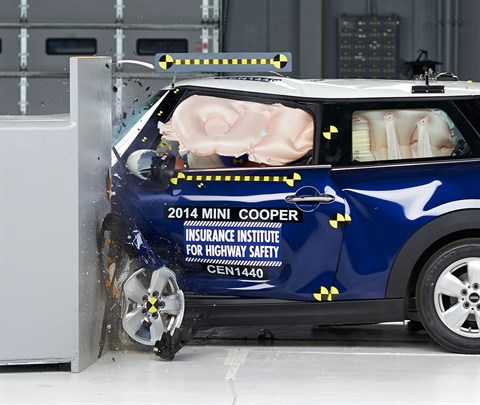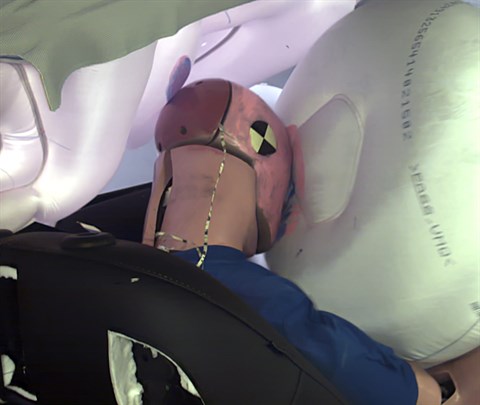Small overlap front: driver-side
Rating applies to 2014-24 models
Tested vehicle: 2014 Mini Cooper 2-door
The Mini Cooper was redesigned for the 2014 model year.
| Overall evaluation | |
|---|---|
| Structure and safety cage | |
| Driver injury measures | |
| Head/neck | |
| Chest | |
| Hip/thigh | |
| Lower leg/foot | |
| Driver restraints and dummy kinematics |

Action shot taken during the small overlap frontal crash test.

The dummy's position in relation to the door frame, steering wheel, and instrument panel after the crash test indicates that the driver's survival space was maintained very well.

The frontal and side curtain airbags worked well together to keep the head from coming close to any stiff structure or outside objects that could cause injury.

The driver's space was maintained well, and risk of injuries to the dummy's legs and feet was low.
Measures of occupant compartment intrusion on driver side
| Test ID | CEN1440 |
|---|---|
| Lower occupant compartment | |
| Lower hinge pillar max (cm) | 7 |
| Footrest (cm) | 7 |
| Left toepan (cm) | 2 |
| Brake pedal (cm) | 5 |
| Parking brake (cm) | |
| Rocker panel lateral average (cm) | 1 |
| Upper occupant compartment | |
| Steering column | 3 |
| Upper hinge pillar max (cm) | 5 |
| Upper dash (cm) | 5 |
| Lower instrument panel (cm) | 4 |
Driver injury measures
| Test ID | CEN1440 |
|---|---|
| Head | |
| HIC-15 | 167 |
| Peak gs at hard contact | no contact |
| Neck | |
| Tension (kN) | 1.1 |
| Extension bending moment (Nm) | 13 |
| Maximum Nij | 0.20 |
| Chest maximum compression (mm) | 24 |
| Femur (kN) | |
| Left | 0.8 |
| Right | 0.0 |
| Knee displacement (mm) | |
| Left | 1 |
| Right | 2 |
| Knee-thigh-hip injury risk (%) | |
| Left | 0 |
| Right | 0 |
| Maximum tibia index | |
| Left | 0.64 |
| Right | 0.28 |
| Tibia axial force (kN) | |
| Left | 2.2 |
| Right | 0.4 |
| Foot acceleration (g) | |
| Left | 93 |
| Right | 52 |
Moderate overlap front: original test
Rating applies to 2014-24 models
Tested vehicle: 2014 Mini Cooper 2-door
The Mini Cooper was redesigned for the 2014 model year. Moderate overlap frontal ratings are assigned by the Institute based on a test conducted by BMW (manufacturer of the Mini).
| Overall evaluation | |
|---|---|
| Structure and safety cage | |
| Driver injury measures | |
| Head/neck | |
| Chest | |
| Leg/foot, left | |
| Leg/foot, right | |
| Driver restraints and dummy kinematics |
Measures of occupant compartment intrusion on driver side
| Test ID | VTF1322 |
|---|---|
| Footwell intrusion | |
| Footrest (cm) | 4 |
| Left (cm) | 8 |
| Center (cm) | 8 |
| Right (cm) | 8 |
| Brake pedal (cm) | 4 |
| Instrument panel rearward movement | |
| Left (cm) | 2 |
| Right (cm) | 2 |
| Steering column movement | |
| Upward (cm) | -1 |
| Rearward (cm) | -5 |
| A-pillar rearward movement (cm) | 2 |
Driver injury measures
| Test ID | VTF1322 |
|---|---|
| Head | |
| HIC-15 | 138 |
| Peak gs at hard contact | no contact |
| Neck | |
| Tension (kN) | 1.2 |
| Extension bending moment (Nm) | 6 |
| Maximum Nij | 0.23 |
| Chest maximum compression (mm) | 35 |
| Legs | |
| Femur force - left (kN) | 0.7 |
| Femur force - right (kN) | 1.0 |
| Knee displacement - left (mm) | 1 |
| Knee displacement - right (mm) | 1 |
| Maximum tibia index - left | 0.39 |
| Maximum tibia index - right | 0.43 |
| Tibia axial force - left (kN) | 2.3 |
| Tibia axial force - right (kN) | 2.5 |
| Foot acceleration (g) | |
| Left | 97 |
| Right | 92 |
Roof strength
Rating applies to 2014-23 models
Tested vehicle: 2015 Mini Cooper 2-door
| Overall evaluation | |
|---|---|
| Curb weight | 2,630 lbs |
| Peak force | 13,532 lbs |
| Strength-to-weight ratio | 5.15 |
Head restraints & seats
Seat type: Manual leather seat
| Overall evaluation | |
|---|---|
| Dynamic rating | |
| Seat/head restraint geometry |
| Seat type | Manual leather seat |
|---|---|
| Geometry | |
| Backset (mm) | 10 |
| Distance below top of head (mm) | 21 |
| Seat design parameters | |
| Pass/fail | Pass |
| Max T1 acceleration (g) | 13.4 |
| Head contact time (ms) | 48 |
| Force rating | 1 |
| Neck forces | |
| Max neck shear force (N) | 1 |
| Max neck tension (N) | 285 |
About the head restraint & seat test
Currently, IIHS tests apply only to front seats.
